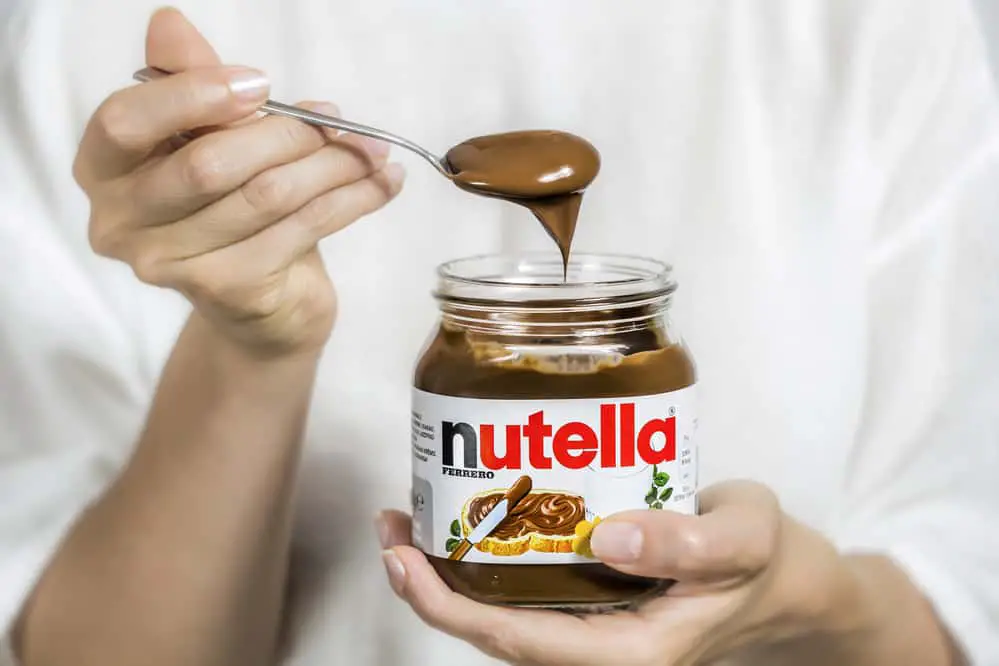Nutella is to Italians what peanut butter is to Americans. Delicious and easy for a quick breakfast or after-school snack, it can be spread on bread, bagels, crackers, or croissants and enjoyed with a glass of milk or used as a dip for slices of bananas, apples, or strawberries. So what exactly is Nutella?
Nutella, the original hazelnut spread, is a combination of roasted hazelnuts, skim milk, and cocoa with a creamy consistency and chocolate taste with a hint of roasted nut flavor.
Nutella is essentially great because it is versatile. You can substitute Nutella in recipes calling for peanut butter and discover a whole new taste sensation. In this comprehensive guide, we are going to take an in-depth look at everything there is to know about Nutella. Read on to find out more.

History of Nutella
Nutella, a delicious combination of ground nuts and cocoa, is one of the most recognizable commercial foods in the world. Its more sophisticated predecessor, gianduja, was created in the early 19th century in Turin, Italy, by chocolatiers who added abundant local hazelnuts to their chocolate.
Today, Nutella is the number one spread in Europe. In Germany, Nutella is a favorite breakfast spread and in both Italy and France it is a popular after-school snack. Worldwide, it outsells all peanut butter brands combined. Nearly three generations of Europeans have grown up eating Nutella, which was created in the 1940s by Pietro Ferrero, a pastry maker and founder of the Ferrero Company.
During the 1940s, cocoa was in short supply due to war rationing and chocolate was considered a real delicacy. So Pietro Ferrero decided to mix cocoa with toasted hazelnuts, cocoa butter, and vegetable oils to create an economical chocolate spread, which he called “pasta gianduja.” It was an immediate success. In February 1946, 660 lbs. were sold. To keep up with the demand, Ferrero worked with local farmers to improve and extend the cultivation of hazelnuts.
In 1949, Ferrero made a “super crema gianduja” which was more creamy and spreadable. This product became so popular that Italian food stores started a service called “The Smearing”. Children could go to their local store with a slice of bread for a “smear” of the chocolate spread. In 1964 super crema gianduja was renamed Nutella. The first jar rolled off the production line in the city of Alba on April 20, 1964, and began to be marketed outside Italy.
Nutella Quicks Facts and Trivia

Each jar contains 13 ounces of Kosher-certified dairy chocolate hazelnut spread and is stamped with a “sell by”date. Nutella can be stored for up to one year. Jars, both unopened and opened, should be stored at room temperature.
Keep the jar tightly closed and stored in a cool place. Do not refrigerate Nutella or it will be difficult to spread. Excessive heat may cause the oils to spread. Simply mix with a spoon to redistribute the oil.
Who would’ve thought that hazelnuts, cocoa, vanillin, sugar, palm oil, lecithin, and milk would be deliciously compatible? That’s why it’s such a big deal. The spread is like no other (sorry strawberry and grape jelly.)
Nutella has been mixed in pancakes, muffins, used on warm toast, etc. It’s no longer just a breakfast spread—it’s a diverse spread.
It’s based on an old Italian recipe
Nutella is a play on gianduja, a mixture of about 70% hazelnut paste and 30% chocolate. It was invented in Turin during Napoleon’s reign around 1800. A blockade of the Mediterranean made chocolate scarce, so chocolatiers mixed it with hazelnuts, which were ample in the region. Gianduja took its name from a popular marionette character.
One simple addition was the secret to its success
In 1951, Pietro Ferrero’s 26-year-old son Michele wanted to find a way to turn his father’s solid block of Pasta Gianduja into something more spreadable and creamy, so after some experimentation, he found the secret ingredient: vegetable oil. Today, Nutella’s primary ingredients are chocolate, hazelnuts, and palm oil.
Its inventor became the richest man in Italy
Due to the success of Nutella and his other invention, Ferrero Rocher, Michele Ferrero became a very wealthy man, surpassing Silvio Berlusconi as Italy’s wealthiest man in 2008. At the time of his death at age 89 in 2015, he’d amassed a fortune of more than $26 billion.
Fun fact: The chocolate layer that surrounds the hazelnut in the middle of each Ferrero Rocher is Nutella.
It can’t be called chocolate cream
Under Italian law, Nutella can only be called hazelnut cream, because it doesn’t meet the criteria for minimum cocoa solids.
Ferrero uses 25% of the global hazelnut supply
Each jar of Nutella contains about 50 hazelnuts.
It’s like spreading a candy bar on bread
Nutella is 70% fat and sugar, and two tablespoons contain 200 calories, 11 grams of fat, and 21 grams of sugar. In fact, Ferrero faced a class action lawsuit a few years ago for falsely advertising that Nutella is nutritious.
There’s a World Nutella day
It’s been held on February 5 every year since 2007, and in 2013 was nearly canceled due to a cease-and-desist letter from Ferrero. Thankfully, the founder and Ferrero reconciled, and it was allowed to continue.
It should probably have been on April 20 anyway, because that’s the date in 1964 when the first jar left the plant.
There’s a commemorative Nutella stamp
In 2014, the Italian postal service released a 50th anniversary commemorative Nutella 70-euro cent stamp, with a jar of Nutella against a golden background.
You shouldn’t refrigerate it
Thanks to the high amount of sugar in Nutella, it’s shelf-stable and will remain edible at room temperature until the best-by date on the jar. If you refrigerate Nutella, the oil from the hazelnuts will harden and it’ll become very difficult to spread.
You can’t name your kid Nutella
Back in 2015, a couple in France attempted to name their daughter Nutella, but a judge actually forbade it, ruling that the name was inappropriate and the girl “risked being mocked.” The name was shortened to something more appropriate: Ella.
Nutella Nutrition Facts

A serving of Nutella (two tablespoons) contains 200 calories, 12 grams fat, 4 grams saturated fat, 15 milligrams sodium, 23 grams carbohydrates, 21 grams sugars, and 2 grams of protein.
A serving of peanut butter (two tablespoons) contains 188 calories, 16 grams fat, 3 grams saturated fat, 8 grams carbs, 2 grams sugars, 7 grams protein, and varying amounts of sodium.
No salt-added varieties have about five milligrams of sodium, while salted PB has about 152 milligrams.
When you consider Nutella versus any nut butter, plain nut butter generally has more healthy fats and protein and fewer carbs and sugars. And pretty much any nut butter tastes great on the same things you’d put Nutella on. To find out the real facts about Nutella, the following will contain some insights from two nutritionists who have studied the product.
“I don’t find any redeeming qualities about Nutella,” says Krista Maguire, R.D., C.S.S.D. and nutrition manager at Beachbody. “Even if it has a little bit of calcium and iron and it’s low in sodium, there are so many more healthful alternatives that you can consume to obtain those nutrients.”
Nutella Ingredients
What really gives Nutella a bad rep is the ingredients list: sugar, palm oil, hazelnuts, cocoa, skim milk, whey, lecithin, and vanillin (artificial flavor).
Sugar
“Ingredients are listed by weight, so that means there is more sugar in Nutella than any other ingredient,” says Maguire, adding that the American Heart Association recommends limiting added sugars to no more than 100 calories per day for women and no more than 150 calories per day for men.
“One serving of Nutella contains 21 grams of sugars, which is 84 calories, or just about all you’re going to get for the full day — and mind you, the recommendation is for the maximum daily amount. You should always shoot for less,” Maguire says.
Less is better as excess sugar consumption has been linked to weight gain, high blood pressure, and increased risk of diabetes and heart disease.
Palm Oil
Adding insult to injury, palm oil is the second ingredient in Nutella. Although all oils contain about 120 calories per tablespoon, it’s best to be mindful of the ratio of saturated to unsaturated fat.
“Palm oil has about seven grams of saturated fat, and about six grams of unsaturated fat per tablespoon, making it a less than stellar choice in the oil department,” Maguire says.
“In addition, most palm oils are highly refined, meaning processed to the point where any benefits have been nullified. Virgin, unrefined palm oil may have some benefits, much like coconut oil, but the jury is still out on that, and that’s not the version of palm oil found in this hazelnut spread,” she adds.
Cocoa and Hazelnuts
After sugar and palm oil, there are some healthy ingredients in Nutella.
“Cocoa has been shown to provide antioxidants, but who knows if they are using highly processed cocoa that’s been heated to death or not,” Maguire says.
“Hazelnuts are the healthiest ingredient on the ingredient list, however being as it’s listed third behind sugar and palm oil, I’m not sure there’s actually many in there, ” she adds.
“Hazelnuts — or nuts in general — are healthful, but when you drown them in sugar, their health value in the context of that food is greatly diminished,” explains Mike Roussell, Ph.D. “For example, no one is saying pecan pie is healthy because it has pecans in it.”
And as for the fact that Nutella is gluten-free? Don’t fall for the health halo of “gluten-free”— the term isn’t equivalent to “healthy.”
Healthy Nutella Alternatives
If all this sounds like you can never have Nutella again, don’t panic. There are ways you can satisfy your craving without all the sugar and oil — and with more nutrition.
“I definitely think you can ‘healthify’ Nutella. Ground up hazelnuts with some pure raw cacao powder could be a wonderful healthy alternative,” Maguire says.
Make your own homemade Nutella, and try these hazelnut recipes when you’re jonesing for a sweet treat:
- Dark Chocolate Hazelnut Spread: This Nutella doppelgänger has only three grams of sugars, but don’t go overboard — two tablespoons of the spread still has 200 calories.
- Hazelnut Latte Protein Balls: Simply combine hazelnuts, oats, nut butter, Cafe Latte Shakeology, chia seeds, and maple syrup in a bowl, then roll into balls for on-the-go healthy snacking.
- Hazelnut Latte Shakeology: Add a little hazelnut extract and nuts to your Cafe Latte Shakeology for a creamy, protein-packed start to your day.
- Chocolate Hazelnut Smoothie Bowl: Smoothie bowls aren’t only for breakfast. This high-protein, the high-fiber recipe makes a satisfying treat any time of day.
And, of course, plain nut butter is always an option. “Almond, peanuts, and cashew butter have a much better nutritional profile. They are higher in protein, lower in saturated fat, and should contain no added sugar if you’re buying the preferred all-natural varieties,” according to Maguire.
Can Nutella Be Part of a Healthy Diet?
When you consider the ingredients, Nutella isn’t a part of a healthy breakfast, Maguire and Roussell say.
“It’s highly processed and filled with sugar, unhealthy fats, and artificial flavors. Any benefits from the nuts are negated by the other ingredients,” Maguire adds.
“The healthfulness of Nutella is essentially a marketing play,” Roussell adds. “Without the marketing telling people that it’s healthy, no one would have thought including Nutella is a healthy part of a breakfast, as I can’t think of one nutritional quality that would make it such.”
However, if you are a true Nutella nut, you can still eat it — in moderation. A teaspoon fix is fine, Maguire says, but natural nut butter is always better, or consider making your own hazelnut spread.
“You can fit anything into your daily total calories, but if you’re looking for results and trying to maximize nutrient density from the calories you consume, Nutella isn’t something that will help you reach those goals,” says Maguire. “Choosing natural almond butter, cashew butter, or grinding up your own hazelnuts — you can even mix in some raw cacao powder — would be a much better alternative.”
Its addictiveness lies in its ingredients. Apart from sugar and fats, Nutella is rich in chocolate. Chocolate contains addictive substances; one of these substances is tryptophan. Tryptophan is an amino acid that is a precursor to serotonin, a neurotransmitter involved in regulating moods. High serotonin levels produce feelings of elation.
Along with tryptophan, there is also phenylethylamine, a neurotransmitter derived from amphetamine. This causes feelings of excitement and attraction.
Tryptophan is an amino acid that is a precursor to serotonin, a neurotransmitter involved in regulating moods

Although it’s difficult to claim that Nutella is nutritious, some claim that it supplies some of the key vitamins and minerals needed for good health. The hazelnut content of Nutella can boost the health of your heart, though its high fat and sugar content is its major downfall. But, it’s the sugar and fat that gives it the properties we love so much.
Made with palm oil, Nutella has easily spread on pretty much anything. From pancakes to bread, it seems Nutella is the go-to for chocolate and nutty goodness. However, the European Food Safety Authority published a study last year, in which the chemical contaminants that result from refining vegetable oils (including palm oil) may increase the risk of cancer.
The hazelnut content of Nutella can boost the health of your heart.
Vegetable oils refined at approximately 200°C are rich in glycidyl fatty acid esters, 3- monochloropropanediol, and 2-monochloropropanediol. As of yet, no tolerable or safe levels have been set for glycidyl fatty acid esters as the group found sufficient evidence it is genotoxic and carcinogenic.
Ferrero claims that the palm oil used in Nutella is refined at temperatures lower than 200°C. Studies have found that unrefined palm oil plays a role in promoting cardiovascular health. In a study published in the British Journal of Biomedical Science, it was reported that despite high levels of saturated fat in palm oil, the oil did not contribute to atherosclerosis and/or arterial thrombosis.
Despite the controversy around its nutritional impact, there is no denying that Nutella is loved all over the world. In fact, American blogger Sara Rosso established World Nutella Day on 5th February 2007. This soon became a global phenomenon with people sharing and spreading their love of Nutella. Ferrero took ownership of this holiday in 2015 to allow it to continue at a larger scale.
Nutella is often advertised as a quick and simple way to make a tasty, kid-friendly breakfast.
Commercials highlight its “simple” and “quality” ingredients, such as hazelnuts and skim milk, but never mention the ingredients that make up the majority of the spread — sugar, and fat.
While there is no question that Nutella tastes good, it should not be considered a healthy ingredient.
Loaded With Sugar
Sugar is the main component of Nutella, giving the spread its sweet taste.
A 2-tablespoon (37-gram) serving contains 21 grams of sugar or about 5 teaspoons.
Shockingly, a serving of Nutella contains more sugar than the same serving size of Betty Crocker Milk Chocolate Rich & Creamy Frosting, which contains 17 grams of sugar.
Limiting foods high in added sugar is critical for your health.
In fact, the American Heart Association recommends that women and children consume no more than 6 teaspoons (25 grams) of added sugar per day, while men should limit their intake to 9 teaspoons (38 grams) Using this rule, a woman or child would be close to their added sugar limit for the entire day after consuming just 2 tablespoons (37 grams) of Nutella.
Consuming too much-added sugar has been linked to a variety of chronic diseases and conditions, including obesity, diabetes, heart disease, liver disease, cognitive decline, and even some types of cancers, including esophageal cancer.
Plus, added sugar may be one of the driving factors behind the surge in childhood obesity
For these reasons, foods with high amounts of added sugar, such as Nutella, should be kept to a minimum.
High in Fat and Calories
Though the recommended serving size is small, 2 tablespoons (37 grams) of Nutella still pack in 200 calories.
Since Nutella is sweet and creamy, it may be hard for some people to stick to the serving size, making it easy to consume an excessive number of calories from Nutella.
Eating one or two servings of it every day could lead to weight gain over time, especially for a child.
What makes Nutella so calorie-dense is the high amount of fat it contains. After sugar, palm oil is the second most abundant ingredient in Nutella.
While fats are beneficial to health in many ways, consuming too much fat can lead to weight gain.
Being overweight or obese increases the risk of many chronic diseases, including heart disease, diabetes, and certain cancers.
Nutella Is More “Natural” Than Some Similar Products
Ferrero advertises Nutella as a product containing simple, quality ingredients.
While it does contain vanillin, a synthetic form of vanilla flavoring, the rest of its ingredients are natural.
One could argue that the limited ingredients found in Nutella make it a better option than other more processed dessert spreads.
For example, Nutella contains far fewer ingredients than most icings and frostings.
It does not contain high-fructose corn syrup, hydrogenated oils, or artificial food colorings, all of which are ingredients of concern for health-conscious consumers.
This may make Nutella more attractive to shoppers who are trying to avoid products made with lots of artificial or highly processed ingredients.
